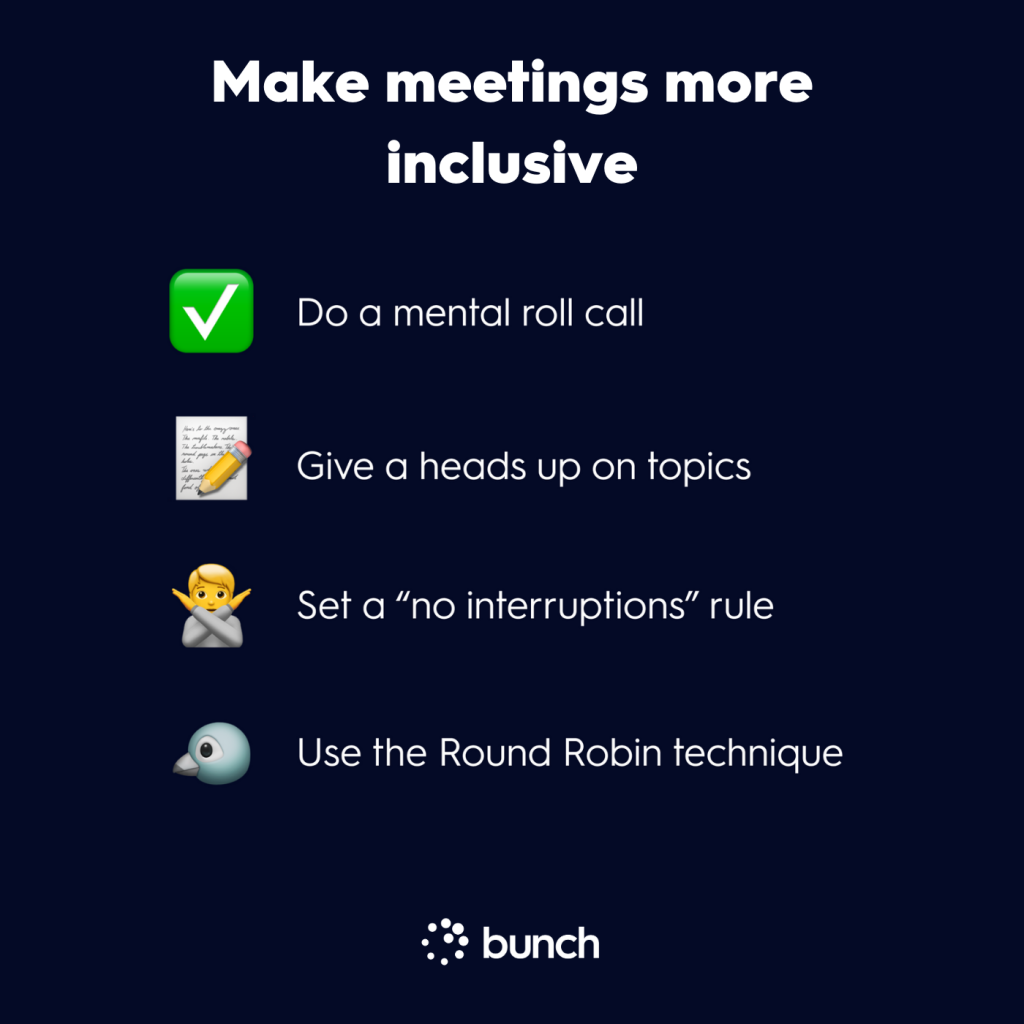What makes people on your team feel like they belong and are valued? Among other things of course, it’s your company’s mission, your policies, and practices, as well as how your team treats their co-workers. According to HBR, it mostly comes down to YOU, as their leader.
What leaders say or do makes up to a 70% difference as to whether a team member feels included. And of course, the more people feel included, speak up, go the extra mile, and collaborate – the better your team will perform.

We create tried and tested leadership tips like this every week. Access them all through the Bunch Leadership Coach!
According to HBR, “Teams with inclusive leaders are 17% more likely to report that they are high performing, 20% more likely to say they make high-quality decisions, and 29% more likely to report behaving collaboratively.”
You’ve probably heard similar statements about the power of inclusive leadership before, (especially right now). But it’s often easier said than done. Not to worry! Bunch is here to support you in practicing inclusive leadership right now with your team.
What is inclusive leadership?
You display inclusive leadership when you are making sure that every member of your team feels respected and valued. This set of leadership behaviors drives individuals to perform better and be more collaborative – giving your entire team a competitive edge.
When you give inclusive leadership the energy it deserves, great things start to happen – teams are happier, more focused, and more productive. Put simply, inclusive leadership is the secret-ingredient not only to more diverse, strategic thinking, the psychological safety of teams, but also high-performance.
In our recent article on binge learning (also called ultra-learning), we examined how lateral thinking works. Leaders who don’t yet practice inclusive leadership limit themselves to vertical thinking. Inclusive leaders can tap into lateral thinking, leading to better idea generation and so much more.
What are the 6 qualities of an inclusive leader?
A Deloitte study of inclusive leaders from Australia, New Zealand, Singapore, Hong Kong, Canada, and the U.S., shows six common characteristics. They are:
- Visible commitment: Using actions (not just words)
- Humility: They are modest and can admit their shortcomings
- Awareness of bias: No “heads in the sand” mentality here!
- Curiosity about others: Seeking to understand others’ cultures and backgrounds
- Cultural intelligence: Aware of others’ cultures
- Effective collaboration: Empowering team members to feel psychologically safe
A leader’s actions have a huge impact on team members and can be the difference between high and low performance. “Subtle words and acts of exclusion by leaders, or overlooking the exclusive behaviors of others, easily reinforces the status quo.”
Ready to start exercising your inclusive leadership muscles? Let’s get to it!
Check out the Bunch Leadership Coach for bite-sized, actionable tips!
Tip #1: Inclusive leaders try to make decisions without implicit bias
The fact is that making decisions as a leader is hard enough. There’s massive pressure, the stakes are typically high, and we’re extremely visible. This makes for a lot of stress, which is usually when our implicit biases kick in. Taking stock of our biases helps us make sure that we’re always in the driver’s seat of our decisions.
One way of doing that is to use some simple practices to keep your implicit biases in check. This can help keep you from making poor hiring decisions, alienating people on your team, and getting tunnel vision – all of which are extremely toxic for your team!
Get back in control of your decision making with these three easy steps:

- Use box breathing – breathe in, hold it, and exhale for 4 seconds each. Stay grounded in the moment to make sure you’re consciously making a decision and not just relying on your quick judgments.
- When in doubt, write it down – if you need to make a decision, make sure you have as much information, and that it’s concrete. This will ensure you’re making the best decision instead of the knee-jerk decision.
- Check yourself with 3 questions – invite an open mindset and a more balanced view by asking:
- What risks am I not taking?
- What or who am I ignoring?
- What am I not seeing?
Addressing implicit biases means that we’re making more conscious decisions. And your teams need you to be making quality choices to drive them forward.
Understanding bias is just one of the ways you can improve your leadership style. Learn more with the Bunch Leadership Coach!
Tip #2: Inclusive leaders make meetings more accessible
Did you know that women are more likely to be interrupted, even by other women? “Over the course of each three-minute conversation, women, on average, interrupted men just once, but interrupted other women 2.8 times. Men interrupted their male conversation partner twice, on average, and interrupted the woman 2.6 times.”
Women on your team are likely struggling to be heard. Inclusive leaders help to level the playing field with a few quick tactics. Here’s what you can do:

- Do a mental roll call – make sure that everyone who should be in a meeting is in the meeting.
- Give a heads up on topics – if you throw topics out there on the fly, you’ll likely only hear the dominant voices on your team. Give everyone a chance to prepare and come ready to share.
- Set a “no interruptions” rule – assign a moderator to the meeting to make sure that the rule is respected and every voice has an opportunity to be heard.
- Use the Round Robin technique – go around the room one-by-one to give everyone an opportunity to share their thoughts.
While it’s great to think that meetings will run smoothly and inclusively without any active effort, it’s just not the case. But practicing inclusive leadership by making meetings more accessible will unlock the potential for many of your more quiet team members.
You may even be surprised to find that some of the most valuable insight comes from previously muffled voices!
Are you looking for more ways to increase your team’s performance? Sign up for early access to the Leadership Coach today.
Leaders who proactively seek out and practice inclusive leadership will see results in the high-performance of their teams. Leaders who understand the personalities and backgrounds of their team members will be able to better lead them.
There’s a lot more work that needs to be done to foster an inclusive workplace. We hope this article was a useful jumping-off point – let us know if you liked it!





